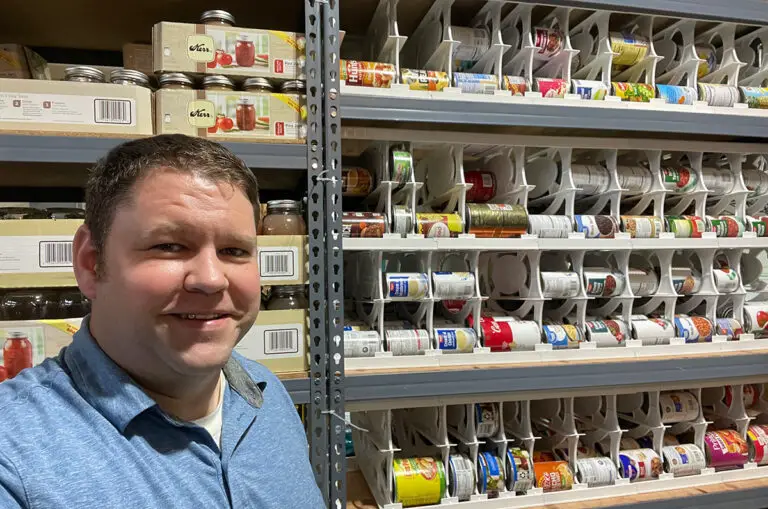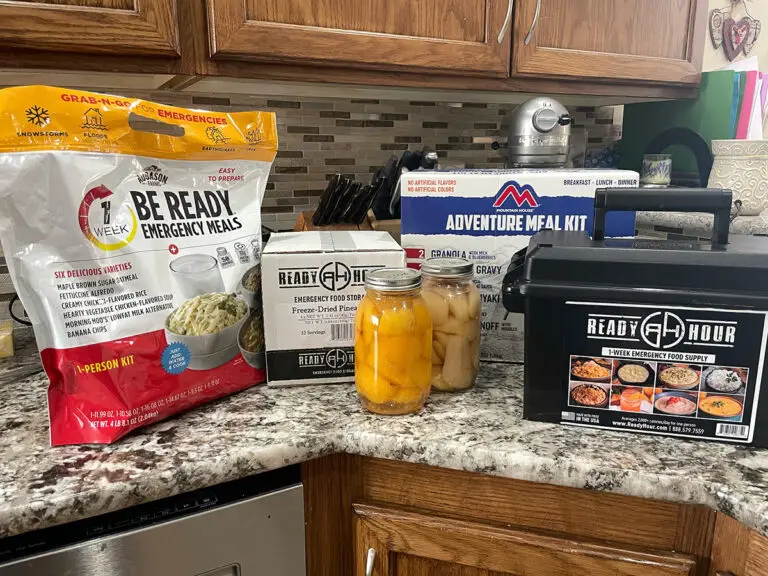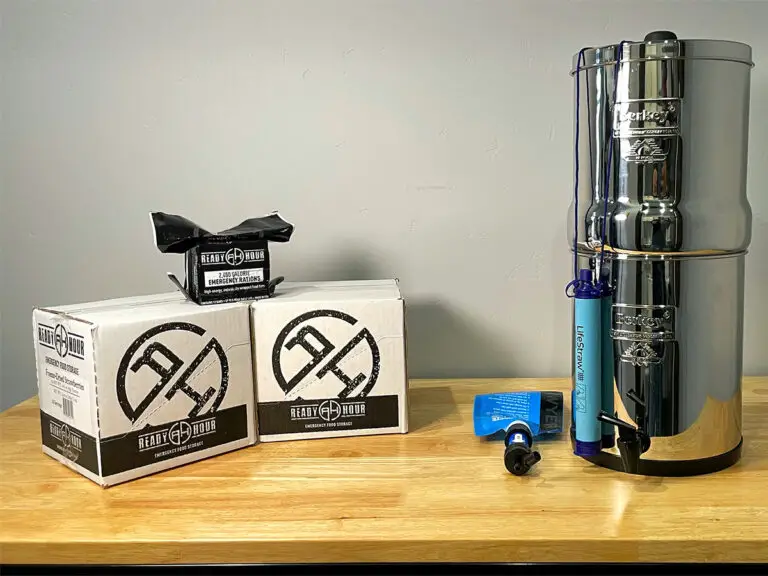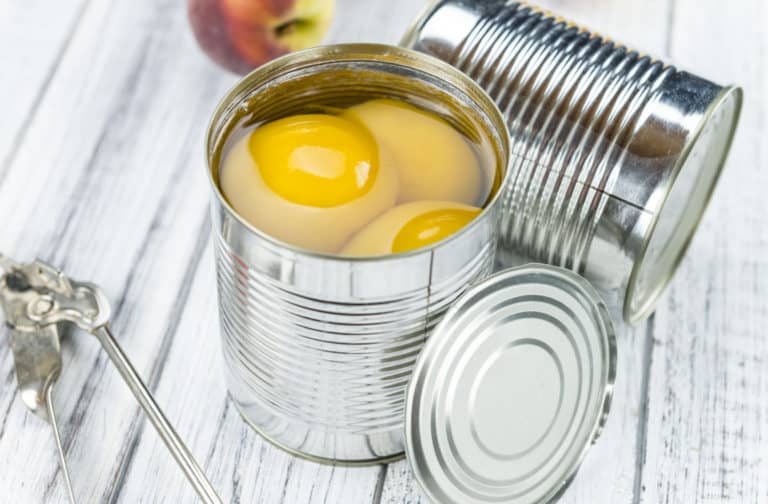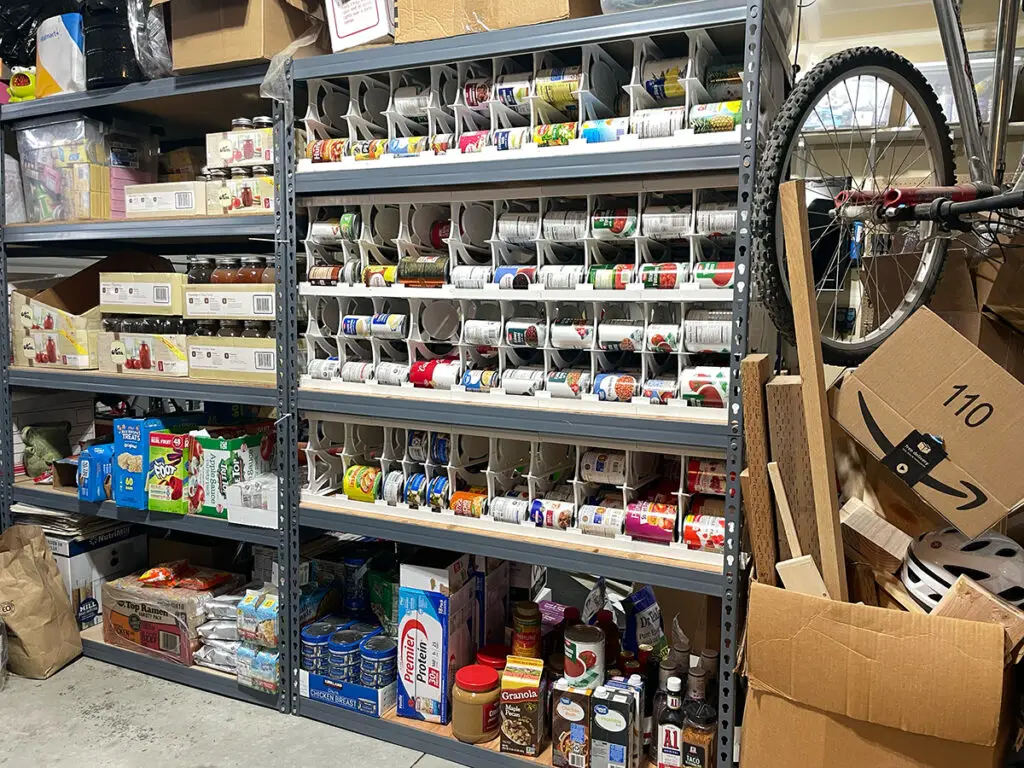
Food storage is essential for preparedness, but a lot of us don’t have big root cellars. Not to mention that few pantries are large enough for long-term food storage. For many of us, that leaves the garage.
Can you safely store food in the garage? Canned food and other shelf-stable food is best stored in cool, dry, dark conditions. If you keep the temperature above freezing and below 85°F (29.4°C), keep the humidity low (below 15% if possible), and minimize direct sunlight then your garage is safe for food storage.
So yes, you can use your garage to store food, as long as you can keep it in the right conditions. Let’s look into that a bit further.
Which Conditions Matter for Food Storage and Why?
Shelf-stable food (canned, dried, etc.) is always given a duration of time that it’s good for. But the duration given is always based on “room temperature” conditions.
For example, when you buy canned peaches from the grocery store, the expiration date on those peaches assumes that they’ll be stored in your house which you typically keep at a fairly stable temperature. Your house is also often dryer than outside during the hot/wet months because air conditioning actually dries the air a bit.
In fact, canned food for tropical areas is actually processed differently from canned food for temperate areas, and the expiration dates are set using the assumption that it’ll be stored somewhere warmer and more humid.
Even if you’re preserving your own food, you’re probably basing how long it’s good for off of guidelines you read somewhere. Well, those guidelines make those same assumptions of room temperature, fairly low humidity, and out of direct sunlight.
So what conditions matter?
Temperature
The USDA states in their Shelf Stable Food Safety Guidelines that temperatures over 100°F are harmful to canned goods and that ideally, you would store canned goods in temperatures below 85°F (29.4C).
That’s because higher temperatures cause food to spoil faster. Yes, even sealed canned foods do spoil and how fast they spoil goes up with temperature.
On the other end, temperatures below freezing could cause contents to freeze which can lower the quality of the food inside as it freezes and thaws, and it can reduce the structural integrity of the can causing it to lose its seal or just wear out more quickly.
Humidity
The USDA doesn’t give specific guidelines on what level of humidity constitutes “dry”. They just say to store canned foods and other shelf-stable products in a cool, dry place.
Food Safety Magazine suggests that you should store dry goods in areas with humidity below 15%. But unless you live in a desert (like I do) 15% is going to be difficult to achieve without using a dehumidifier.
The USDA guidelines just say to not store food under sinks or in particularly damp basements or garages. If your garage is about as humid as your house, then it’s not going to be any worse than storing your food in a kitchen pantry (at least from a humidity perspective).
Humidity is important because moisture contributes to spoiling in dry foods. It also leads to rust on cans which reduces the structural integrity of the cans storing your food. So when it comes to canned foods, it could shorten the life of the can, especially for those dry canned foods that can last up to 30 years. And for other shelf-stable dry foods (not canned) humidity could shorten their life substantially.
Sunlight
Direct sunlight isn’t good for shelf-stable foods because it can cause lots of good vitamins and nutrients to degrade. Direct sunlight can also cause your food (even canned food) to heat up, even beyond the average temperature of the room where it’s stored.
So if you store food in direct sunlight, you may be heating it up a lot more than you think.
How to Make Your Garage Safe for Food Storage
At this point, you may have already determined that your garage is good to go for food storage! But in most cases, temperate (at the very least) is going to be an issue.
Most garages aren’t temperature-regulated like the rest of the house, and in many cases, they’re not even insulated. So in the winter, it’s possible to reach freezing temperatures, and in the summer it’s possible to reach temperatures well over 100°F depending on where you live.
So let’s talk about how to make your garage safe for food storage.
Control Room Temperature
First things first, we need to find out if your garage is suitable for food storage.
The best way to do that is to start tracking the temperature in your garage over time. This temperature and humidity monitor available on Amazon is inexpensive and will track the temperature and humidity of your garage for you over time so you can see what the highs and lows are.
You probably don’t want to wait a year to see how big your temperature swings are before using your garage for food storage. So just try it out for a few weeks. If it’s winter, see how low it goes. If it’s summer, see how high it goes.
If you live in a climate that gets pretty cold and your garage stays above freezing every day during the winter, then your garage is probably going to be okay for temperature.
If you live in a hot climate and it’s summer, then if your garage temperature doesn’t go much above 85° then it’s probably going to be fine year-round.
Then, monitor the temperature. Check in every week or two and see if the temperature is staying in the safe zone.
If it’s not, then we need to start looking at solutions.
There are 2 big issues that cause huge temperature swings in your garage.
- Poor Insulation
- Lack of Temperature Control
Insulation is tough to fix, especially if your garage has been at all “finished”. But just because you have enclosed walls in your garage doesn’t mean that you can’t insulate them.
If you want to insulate a finished wall, spray foam insulation could be a good option. This video explains how that works.
That said, spray foam insulation is going to be more expensive than adding some blown-in insulation in attic space above your garage (if applicable). You also might consider a solar attic fan (like this one on Amazon) to help keep the temperature in your garage considerably cooler in the hot months.
Temperature control for your garage doesn’t have to be as bad.
You have a couple of options when it comes to adding temperature control to a garage.
First, you can add a vent (or two) from your existing HVAC system to the garage. For this, you’ll probably need to reach out to an HVAC contractor. The downsides to this option are up-front cost (of having it done) and lack of temperature control in the garage.
If you go this route, there’s no guarantee you’ll keep the garage inside the temperature range. You’ll get cool air when your system is cooling your house, and warm air when it’s heating. But it wouldn’t make financial sense to add a thermostat and a full zone to your HVAC system just for the garage.
That brings us to the second option, which is to purchase a mini-split or a portable heater/air conditioner for the garage.
I really like this portable 4-in-1 heater/air conditioner/dehumidifier/fan from DeLonghi. You can get it on Amazon, but I got mine from Costco. It’ll heat, cool, and even dehumidify your garage if needed. I also really like the hose vent over the window A/C unit.
Depending on how big your garage is, it might or might not be powerful enough though. That’s where a mini-split may be your best option.
A mini split is just a ductless air conditioner (and sometimes a heater) that mounts on the wall and heats/cools a single room. You can get one that’s just the right size for your garage. And it would be controlled with a built-in thermostat so you’d keep the garage right in the ideal temperature range.
A mini split isn’t going to be cheap though, so I’d definitely track your garage temperature over time to determine if you really need one or not.
Control Your Garage Humidity for Safe Food Storage
Humidity probably isn’t going to be as big of an issue unless your garage is significantly more humid than your home.
To test that, I suggest also using this temperature and humidity monitor available on Amazon to test out the humidity in your home and then in your garage. Is it significantly higher? If it is, you’ll want to work on it. If not, it’s probably fine.
I do want to point out that humidity percentages are relative and based on temperature. What that means is that at higher air temperatures, the air can hold more water. And since humidity percentages are based on how much water the air can hold, the same humidity number at warmer temperatures actually means more water in the air than at lower temperatures.
So the 15% humidity number isn’t necessarily the best indicator of what level of moisture in the air is safe for shelf-stable food. However, the humidity percentage (called relative humidity) is the easiest way of measuring moisture in the air, and it’s the number humidity monitors will give you.
The point here is that as long as the moisture content in the air in your garage is similar to the rest of your house, the garage is no worse for food storage than an indoor pantry. At least from a humidity perspective.
Keep Shelf Stable Food Out of Direct Sunlight
This one is relatively easy compared to the last two.
If you have windows that let in a lot of sunlight in your garage, you’ll want to make sure you keep your food storage in a place in the garage that doesn’t get that direct sunlight.
You might also consider putting up some blinds and/or curtains to keep that direct sunlight out if there isn’t a fairly dark area in your garage.
Don’t Store Food in the Garage if you Also Store Gas or other Chemicals There
One last note about storing food in the garage… don’t use the garage if you’re also using it to store chemicals that are dangerous to ingest.
For years, I stored gas cans in the garage. But now that I use the garage for food storage (and other storage) I keep gas and other dangerous chemicals in a shed or outbuilding. I also keep my lawn mower, trimmer, leaf blower, and other gas-run tools out there.
A lot of chemicals—especially gasoline—evaporate really and permeate through the air. A lot of those chemicals are also really corrosive meaning even their evaporated form can actually cause degradation to cans and other packaging. So if you have gasoline, pesticides, or other dangerous chemicals in your garage, then your food storage may actually get contaminated with those chemicals.
It May Not Be Practical to Store Food in the Garage
I’ve listed a lot of problems with storing food in the garage. Every one of those issues can be overcome. In fact, I keep most of my food storage in the garage. But if you can’t overcome the temperature issue, or if you don’t have any other place to store lawn tools and gasoline, the garage may not be the best place for your food.
If that’s the case for you, you should definitely consider looking at the many ideas out there for creative home food storage solutions. There are often unused spaces under beds, in closets, and in the far corners of cabinets that can be great for storing food.


